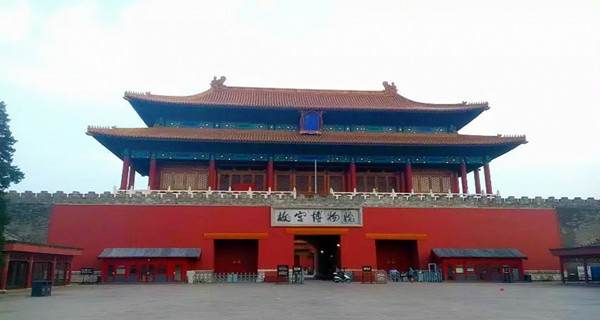
【The Meridian Gate】
The Meridian Gate, the main entrance of the Forbidden City in Beijing, is located in the north-south axis of the Forbidden City. This door is centered with a sunny exposure where is the meridian, hence the name Meridian Gate. It was first built in the Ming Dynasty Yongle 18 Year (1420), rebuilt in the Qing Dynasty Shunzhi 4 Year (1647), and again repaired in the Qing Dynasty Jiaqing 6 Year (1801).
【Gate of Heavenly Purity】
Gate of Heavenly Purity (Qianqing Men) is located behind Hall of Preserving Harmony in Forbidden City, Beijing. The gate was originally built in 1420 in Ming Dynasty, and then was rebuilt in 1655 in Qing Dynasty. In front of the Gate of Heavenly Purity, there is a quite long but narrow square. The square has a rectangular square. Longzong Gate is sited in the west of Gate of Heavenly Purity Square Silom sect west, and Jingyun Gate in the east. The Gate of Heavenly Purity separates the Forbidden City into the Outer and Inner Court. The northern side of the gate is called Inner Court, including the Palace of Heavenly Purity. It is the residential region inside the Forbidden City. The southern side of the gate is called Outer Court, including Hall of Central Harmony, Hall of Preserving Harmony, Hall of Supreme Harmony, Hall of Literary Glory and Hall of Military Prowess.
【Gate of Supreme Harmony】
Gate of Supreme Harmony is the main entrance the Outer Court, as well as the largest palace gate within the Forbidden City. When originally built in Ming Dynasty, it was called Fengtianmen. It is the door for the Hall of Supreme Harmony (commonly known as the Throne Room). It was a magnificent door with the highest standard in ancient China. The gate is three bays deep and seven bays wide, with a construction area of about 1300 square meters.
The gate has white marble pedestal and r paintings on wood beams and Fang. There are four bronze tripods in front of the gate, which were bronze furnishings made in the Ming Dynasty. Bronze lion one pair of columns, the left female male Right, mighty aggressive, are six pairs of bronze lion in Forbidden largest pair. There are two bronze lions on both side of the gate, which represent imperial power. The two bronze lions are the largest pair in Forbidden City. The lion on the east side is male and on the west side female. They look mighty and aggressive in front of the gate, symbolizing a flourishing and prosperity imperial family.
【Gate of Devine Might】
Gate of Devine Might (Shenwu Gate) is the north gate of the Beijing Forbidden City. It was first built in the Ming Yongle 18 Year (1420) and was called Xunwu Gate during that period. Xuanwu is one of the four ancient mythical creatures, speaking from orientation, the Green Dragon was on left, the White Tiger was on right, the Vermilion Bird was in the front, and the Xuanwu was in the back. Xuanwu represents the north, hence, most of the north gate of the imperial palaces were named "Xuanwu". The gate was built in Qing Emperor Kangxi period, and was renamed "Shenwu Gate".
【Palace of Earthly Tranquility】
Palace of Earthly Tranquility (Kunning Palace), the internal construction of the Forbidden City in Beijing, is one of the queen's palace. Since Emperor Yongzheng of the Qing Dynasty, Kunning palace was nominal main palace, but the actual use was the shamanic's ritual spaces and the emperor's wedding bridal chamber. Palace of Heavenly Purity represents masculine gender, and Kunning palace represents feminine gender, combining those means combination of masculine and feminine.
【Palace of Heavenly Purity】
Palace of Heavenly Purity (Qian Qing Gong), one of three imperial harems, is the main hall of the imperial palace in Beijing Forbidden City. It is the place for the residence and the day-to-day public affairs of Ming and Qing emperors in the Forbidden City. It is the first of the three imperial harems, locate inside the Gate of Celestial Purity. "Qian" means "Heaven", and "Qing" means "Purity"; the name of this palace means: lucid sky - a symbol of national stability, also a symbol of the emperor's clear and magnanimous behavior.
【Hall of Preserving Harmony】
Hall of Preserving Harmony (Baohe Hall) is one of the three main halls in the outer palace of the Beijing Forbidden City, located behind the Hall of Central Harmony. It was built in 1420 and first named "Jinshen Hall". It was renamed "Baohe Hall" in Qing Shunzhi 2 Year, which means the single-minded consciousness and maintaining the harmony to get the happiness, longevity and peace for the country. The hall was once the place for the emperor to confer titles of nobility on the queen and the prince in the Ming Dynasty, also the living place for the Qing Emperor Shunzhi and Emperor Kangxi, the place for holding the feudal imperial examination in Qing Emperor Qianlong period.
【Hall of Supreme Harmony】
The Hall of Supreme Harmony, also known as the Hall of Golden Chime, is one of the ‘three main palaces’ in Beijing Forbidden City, and it is China's existing largest wood structure palace. It is located in a powerful and influential position of the north-south main axis in the Forbidden City. It was first built in 1420 and through many times destroy by fire and rebuilt.
Source: topchinatravel.com



